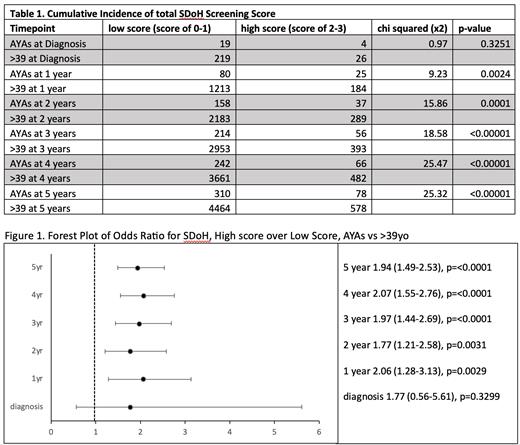Introduction
The majority of AYAs, ages 15-39, are treated outside of major academic centers and recent data suggests inferior outcomes for these patients. Social determinants of health play an important role in the outcomes for AYAs due to longer duration of survival, less established social networks, diminished support systems, and financial toxicity. Here we report SDoH data from self-reported screening questionnaires in the EPIC electronic medical record (EMR). The purpose of this study was to examine differences in SDoH between AYAs and older adults from diagnosis of hematological malignancy through 5 years at a nonprofit public safety-net health system in Cleveland, Ohio.
Methods
Using a retrospective cohort design, patients with hematological malignancies (acute/chronic leukemia, lymphoma, myelodysplastic syndrome, myeloproliferative neoplasms, etc.) identified in the EMR by ICD code, were assigned two groups, AYAs (15-39) and older adults (>39 years of age). Social determinants of health data screenings for Alcohol Use, Depression, Financial Resource Strain, Food Insecurity, and Transportation Needs were evaluated beginning at malignancy diagnosis through 5 years. Scores for each item rated from 0 to 3 based on 3 questions pertaining to each item. Data was stratified by low scores (0 to 1) and high scores (2 to 3) and cumulative incidence was obtained at timepoints of diagnosis (-7 to +7 days), and annually through year 5 from diagnosis. Statistical significance was performed using Kruskal-Wallis chi square analysis and odds ratios (OR).
Results
A total of 1710 patients with 11010 screens were identified from days 7 prior to diagnosis to 12070 after diagnosis. Any positive score (score of 1 to 3) was obtained in 93% of AYA screens and 95% of >39 years of age screens. To further investigate the degree of positivity of SDoH screen, scores were stratified by low (0 to 1) and high (2 to 3). At initial diagnosis, no statistical difference between AYAs and >39 years was found (x 2=0.97, p=0.3251). A statistical difference was seen for cumulative incidence at all timepoints after diagnosis: 1 year x 2=9.23, p=.0024; 2 years x 2=15.86, p=0.0001; 3 years x 2=18.58, p<0.00001; 4 years x 2=25.47, p<0.00001; 5 years x 2=25.32, p<0.00001 (table 1). Odds ratios (with 95% CI) were statistically significant at all timepoints after diagnosis: 1 year 2.06 (1.28-3.13), p=0.0029; 2 years 1.77 (1.21-2.58), p=0.0031; 3 years 1.97 (1.44-2.69), p=<0.0001; 4 years 2.07 (1.55-2.76), p=<0.0001; 5 years 1.94 (1.49-2.53), p=<0.0001, (figure 1). Most prominently positive were self-reported depression screens in AYAs at 1 year (x 2=6.54, p=0.0105), 2 years (x 2=16.35, p=.0001), 3 years (x 2=21.42, p<0.00001), 4 years (x 2=19.09, p<0.00001), 5 years (x 2=26.86, p<0.00001). Lastly, we assessed annual incidences for total SDoH screens which showed significance at 1 year (x 2=8.73, p=.0031), 3 years (x 2=11.04, p=.0009), and 4 years (x 2=7.96, p=.0048) but not at 2 or 5 years (x 2=1.17, p=0.2798 and x 2=1.40, p=0.2373, respectively).
Conclusions
Within a highly vulnerable population at a public safety-net hospital, AYAs with hematological malignancies had a statistically significant higher proportion of self-reported Alcohol Use, Depression, Financial Resource Strain, Food Insecurity, and Transportation Needs versus older adults. While no statistical difference existed at time of diagnosis, a larger proportion of high-risk scores were seen beginning at 1 year after diagnosis through 5 years after diagnosis. In addition, odds ratios were most prominent at 1 year and 4 years after diagnosis possibly suggesting a higher social toxicity seen by AYAs in active treatment and survivorship. Specific attention should be given to mental health services for AYAs throughout treatment and prospective observation studies should be done in order to confirm the observed results. In addition, further research is needed to assess the role of hospital setting type (academic, county, community) and presence of an AYA program on social determinants of health for AYAs as well as implementation of social interventions that may mitigate these outcomes.
Disclosures
No relevant conflicts of interest to declare.


This feature is available to Subscribers Only
Sign In or Create an Account Close Modal